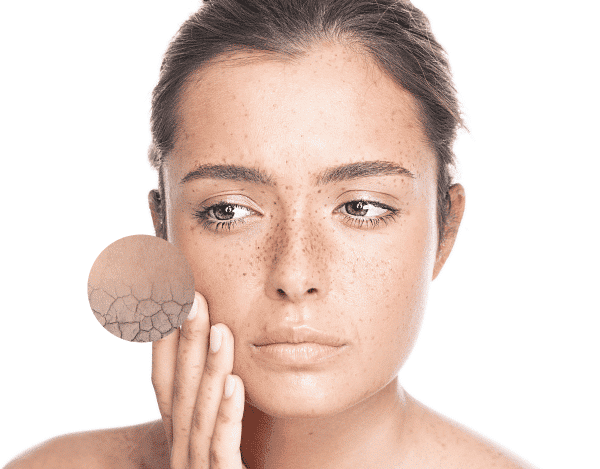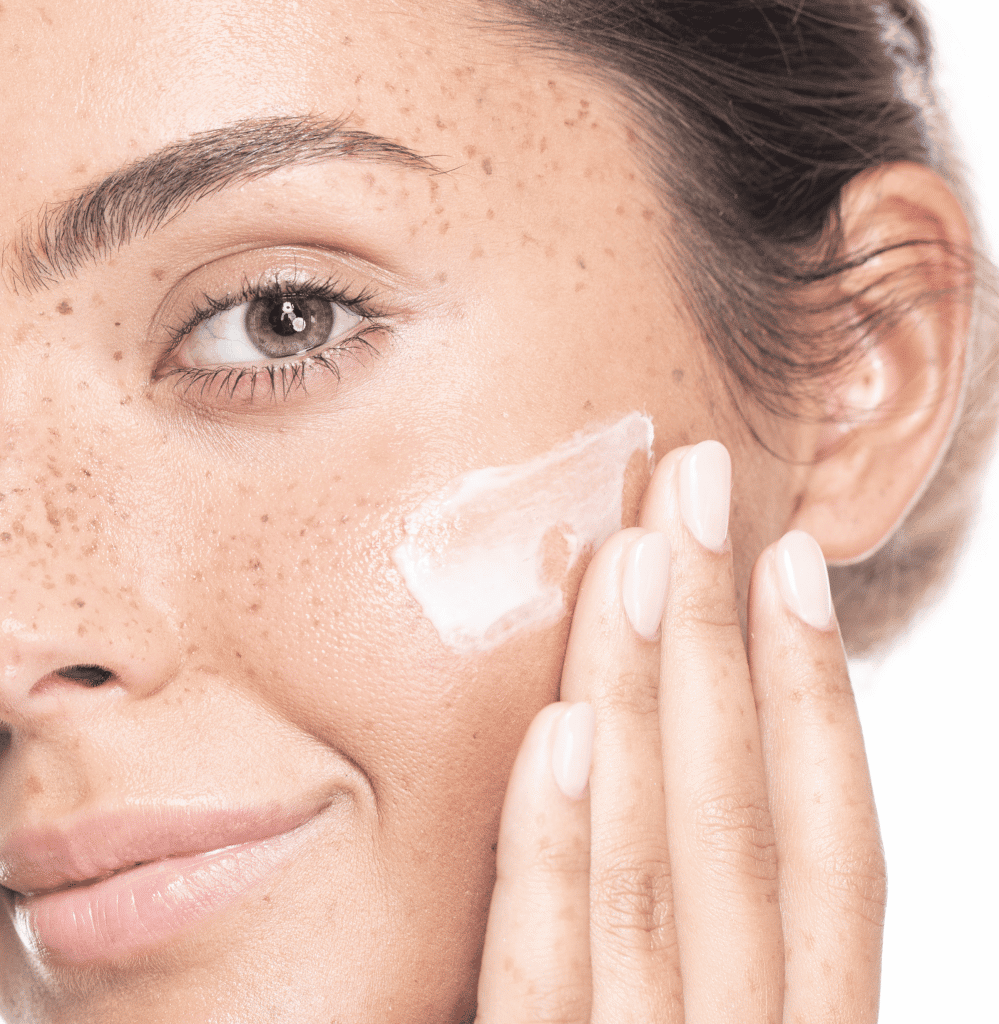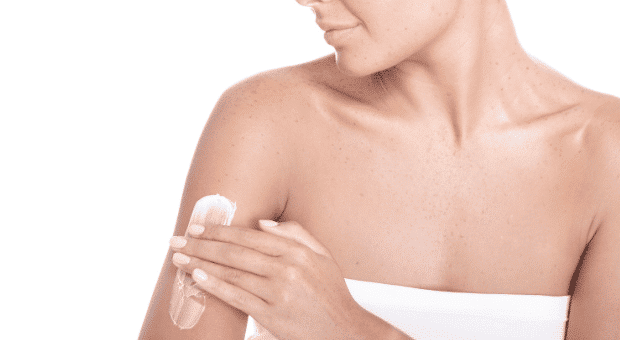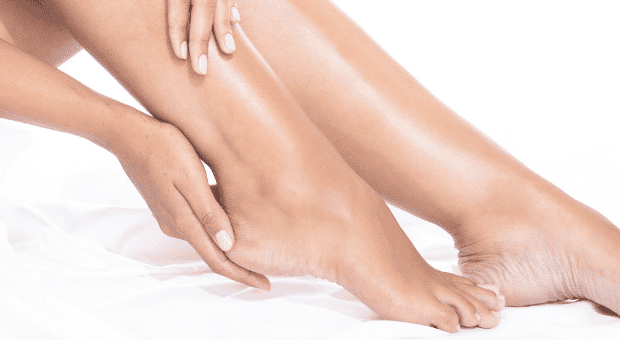

Dry skin is a common problem that can occur not only on the legs or feet, but also on the face. Depending on the severity, dry facial skin can cause roughness and a slight feeling of tightness. Extremely dry skin, on the other hand, is characterized by an extreme feeling of tightness, flaking and severe itching.
Whether you are prone to dry skin also depends on your skin type. For example, people with normal or combination skin struggle with dryness symptoms more often than those whose facial skin is more oily. However, those with more oily skin may also experience redness and flaking, which is misinterpreted as “dry skin.” The so-called seborrheic (oily) scaling usually occurs at the hairline, in the eyebrows and in the area of the nasolabial fold. If you suffer from this type of scaling, it is advisable to consult a dermatologist. If it is scaling, dryness and tension of the skin in the area of the cheeks, the eye region or on the eyelids, this speaks for the typical dry skin, which usually corresponds to a minimal form of neurodermatitis in the facial area and which you can counteract with an optimal care for dry facial skin.
There are many reasons for extremely dry skin on the face. Skin diseases such as psoriasis and neurodermatitis can also lead to an altered skin appearance in the face (here you can find more information on dry facial skin due to skin diseases such as neurodermatitis and psoriasis). But dryness in the face can also occur alongside these skin diseases.
Basically, dry skin always occurs when the skin barrier is disturbed, causing increased evaporation of moisture from the skin. The cause of this is, among other things, a lack of the skin’s own moisturizing factors (hydrolipid film), which results in increased transepidermal water loss and thus causes the upper skin layer to dry out. The effect is intensified by a disturbed skin barrier as a result of reduced lipid formation, which significantly increases moisture loss. Dry skin is the result.
In general, it should be noted that the facial skin is much more sensitive and thinner than other skin areas of the body. At the same time, considering that the face is one of the only areas of the body that remains uncovered and under the influence of the sun, dirt and other factors throughout all seasons, the facial skin has to do an incredible job for us every day. This performance can be affected by internal and external factors.

In the colder months, we expose our facial skin to both cold outdoor temperatures and dry heating air. These ultimately cause the skin to dry out. (You can learn more about proper skin care for dry skin in winter here). However, inappropriate daily facial care can also lead to increased dryness on the face. Frequent washing, aggressive skin care products and long, hot baths or showers disrupt the skin’s protective film and the facial skin dries out. Direct mechanical stress to the skin, for example by wearing a mouth-nose guard, can also cause dryness (learn more about this topic here). Excessive sun exposure can also have a negative effect on the facial skin. It is therefore advisable to use a day cream with a sun protection factor (SPF) and, in the case of sunscreen, to ensure that it also contains moisture-binding active ingredients in addition to the appropriate SPF.
In order for our skin to protect us from external influences, certain basic conditions must be met. However, these can vary from person to person. Our genes determine skin characteristics such as pigmentation, skin barrier strength, moisture and lipid content. This means that the skin of different people contains different amounts of moisture and lipids under identical conditions.
The most common internal factors that can cause dry skin on the face are genetic predisposition (neurodermatitis tendency), hormones, and a person’s age. If hormone levels change during adolescence or menopause, for example, this can also affect the moisture balance in the skin. During menopause, estrogen levels drop and this usually causes more moisture loss and less sebum and lipid production in the skin – so it becomes drier with age. Age therefore also plays a role when it comes to dry skin on the face The older you get, the more your skin tends to dry out and lose its tone and elasticity. Sometimes psychological stress also worsens skin dryness.

Around the eyes, the skin is even thinner compared to the rest of the face. Because there are also fewer lipid-donating sebaceous glands in this area of the skin, the moisture depot there can decrease more quickly. In addition, the skin area is heavily stressed by UV rays, environmental influences and facial expressions when laughing or blinking and requires special care. As with dehydrated skin and dry skin in general, you can restore moisture to the dry eye area with the right care. It is important to use an eye cream whose structure is adapted to this special facial region.
If the care does not contain any moisturizing factors, the deeper layers of the facial skin also dry out again quickly and the moisture balance is disturbed. The moisture can therefore also no longer be sufficiently bound and transported to the upper layers. The result: the skin continues to dry out. For this reason, dry skin on the face needs coordinated care to replenish the lost moisture and to protect it from further moisture loss. Urea is an ideal moisture binder that retains water in the skin. Therefore, skin creams containing urea are optimal for moisturizing the skin, support the regeneration of the disturbed skin protective barrier and help extremely dry skin to restore its protective function.

Due to the everyday wearing of a protective mask, our facial skin faces great challenges. As a result, irritation, impurities and dry patches can occur on the face, especially in sensitive skin. But even normal skin often shows irritations and skin irritations due to the increased use of a mouthguard, which can eventually lead to dry skin under the mask.
Limy water can lead to dry skin and skin diseases. Learn more about the influence of water hardness on our skin here.

Learn how your skin changes from 30 and how you can delay the natural aging process by means of optimal facial care.

The skin protects the body from external influences. But the skin itself also needs protection: the skin's microbiome is responsible for this.
Dryness on the legs, rough knees or scaly shins are not only unpleasant, but also indicate that the skin in these areas lacks moisture and care. But what exactly is the cause of rough and dry skin on the legs and what can you do to restore enough moisture to the dried-out skin? Learn tips and tricks on how to avoid dry skin on your legs.

Struggling with dryness and cracking on your heels? Here you can learn more about the prevention and treatment of chapped or dry feet.